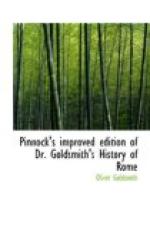22. The public roads were little inferior to the aqueducts and Cloa’cae in utility and costliness; the chief was the Appian road from Rome to Brundu’sium; it extended three hundred and fifty miles, and was paved with huge squares through its entire length. After the lapse of nineteen centuries many parts of it are still as perfect as when it was first made.
23. The Appian road passed through the following towns; Ari’cia, Fo’rum Ap’pii, An’xur or Terraci’na, Fun’di, Mintur’nae, Sinue’ssa, Cap’ua, Can’dium, Beneven’tum, Equotu’ticum, Herdo’nia, Canu’sium, Ba’rium, and Brundu’sium. Between Fo’rum Ap’pii and Terraci’na lie the celebrated Pomptine marshes, formed by the overflowing of some small streams. In the flourishing ages of Roman history these pestilential marshes did not exist, or were confined to a very limited space; but from the decline of the Roman empire, the waters gradually encroached, until the successful exertions made by the Pontiffs in modern times to arrest their baleful progress. Before the drainage of Pope Sixtus, the marshes covered at least thirteen thousand acres of ground, which in the earlier ages was the most fruitful portion of the Italian soil.
Questions for Examination.
1. When was Rome founded?
2. What ceremonies were used in determining the pomcerium?
3. How was the comitium consecrated?
4. What was the first addition made to Rome?
5. What was the next addition?
6. Into what tribes were the Romans divided?
7. What were the hills added in later times to Rome?
8. Had the Romans any buildings north of the Tiber?
9. When did Rome become a magnificent city?
10. What was the extent of the city?
11. How was the city divided?
12. Which was the most remarkable of the seven hills?
13. What buildings were on the Capitoline hill?
14. What description is given of the forum?
15. Where was the senate-house and comitium?
16. What use was made of the Campus Martius?
17. What was the Pantheon?
18. Were the theatres and circii remarkable?
19. Had the Romans public baths?
20. How was the city supplied with water?
21. Were the cloacae remarkable for their size?
22. Which was the chief Italian road?
23. What were the most remarkable places on the Appian road?
FOOTNOTES:
[1] Hence a gate was called porta, from porta’re, to carry. The reason of this part of the ceremony was, that the plough being deemed holy, it was unlawful that any thing unclean should pollute the place which it had touched; but it was obviously necessary that things clean and unclean should pass through the gates of the city. It is remarkable that all the ceremonies here mentioned were imitated from the Tuscans.




